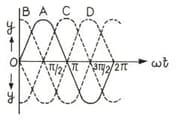MEDIUM
Physics
IMPORTANT
Earn 100
The linear density of a vibrating string is . A transverse wave is propagating on the string, which is described by the equation , where and are in metre and the time is in second. The tension in the string is
(a)
(b)
(c)
(d)
66.67% studentsanswered this correctly

Important Questions on Travelling Waves
MEDIUM
Physics
IMPORTANT
The amplitude of a wave represented by displacement equation will be
EASY
Physics
IMPORTANT
A plane sound wave is travelling in a medium. In reference to a frame A, its equation is . Which reference to frame B, moving with a constant velocity in the direction of propagation of the wave, equation of the wave will be
MEDIUM
Physics
IMPORTANT
Two blocks of masses and are connected by a wire that has a linear mass density of . These blocks are being pulled across horizontal frictionless floor by horizontal force that is applied to block. A transverse wave travels on the wave between the blocks with a speed of (relative to the wire). The mass of the wire is negligible compared to the mass of the blocks. The magnitude of F is
MEDIUM
Physics
IMPORTANT
At , the shape of a travelling pulse is given by where and are in metres. The wave function for the travelling pulse if the velocity of propagation is in the x direction is given by
EASY
Physics
IMPORTANT
Two particles of a medium, disturbed by the wave propagation, are at and . The respective displacements (in ) of the particles can be given by the equations:
and .
The wave velocity is
MEDIUM
Physics
IMPORTANT
At , a transverse wave pulse travelling in the positive direction with a speed of in a wire is described by the function given that . Transverse velocity of a particle at and is
MEDIUM
Physics
IMPORTANT
Sinusoidal waves in amplitude are to be transmitted along a string having a linear mass density equal to . If the source can deliver a maximum power of and the string is under a tension of , then the highest frequency at which the source can operate is (Take )
EASY
Physics
IMPORTANT
The figure shows four progressive waves A, B, C and D. It can be concluded from the figure that with respect to wave A :

